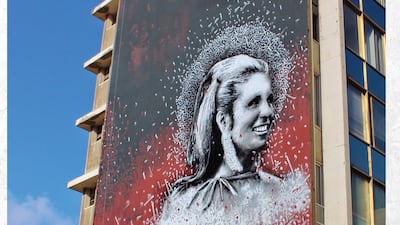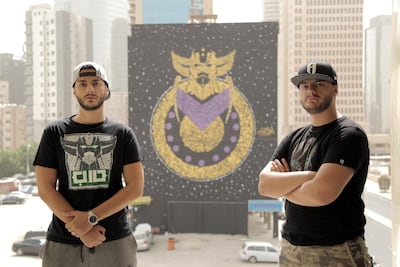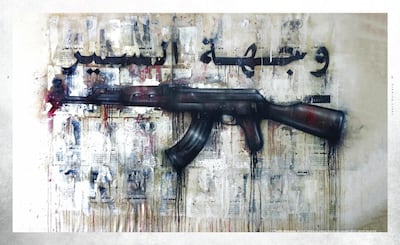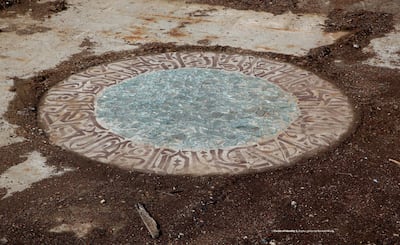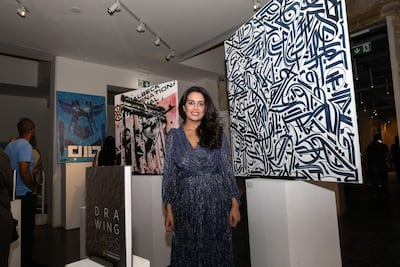Beit Beirut museum last week hosted a small exhibition by local, regional and international artists who have contributed to the book Drawing Lines, which gathers street art and explores perceptions of Lebanese identity.
The figure is recognisable: Grendizer, the children's cartoon hero from the 1970s. But its surrounding is covered with Arabic calligraphy on a dark blue base, like a manifest of power in the hall of Beit Beirut. The graffiti, drawn by Ashekman, a street art team made up of twin bothers, Omar and Mohamed Kabbani, represents for them a hero saving people from evil, a symbol the brothers use as a mascot.
"We used to watch Grendizer on TV in shelters during the war [the Lebanese civil conflict of 1975-1990] on the only station ... and it's this robot who saves the world, so we make it everywhere we go, in Lebanon and abroad," Omar tells The National. "It is the saviour, it brings hope to people in a world full of vice and bad guys."
Both are very influenced by what happened to them during the civil war, having spent most of their first 10 years in shelters. "We used to go to school and see the militias," Omar says. "All that inspired us to do art and that's why we started almost 20 years ago, to leave a message in the city, a positive one. We are like mirrors of society and we live between several volcanoes, Palestine, Syria, Iraq." He says that their message is, for example, "Not to follow your leader but Grendizer instead, because he will never die."
The brothers use Arabic calligraphy to convey the idea that the script is about art and culture, not just terrorism: "As Arab street artists, we have this responsibility to change people's perception". They took part in the book to put Lebanon on the world map of street art and to shed a positive light on local creativity. The initiative came from author Tamara Zantout, who lived in London for most of her childhood with her parents, who fled the Lebanese war. Her book gathers the works of about 20 artists, such as Yazan Halwani, Said Mahmoud and Karim Tamerji, Fish and Benoit Debbane, whose tags appear on walls across Beirut.
Drawing Lines focuses on the perception of Lebanese identity through the poetic analysis of street-art lenses such as revolt, iconography, journey, identity and heritage. For that, Zantout spent two and a half years documenting the art and interviewing artists, but also launching urban interventions, notably at the now destroyed former Grande Brasserie du Levant, with the French artist Zepha.
She toured with two photographers, Bernard Khalil and Loryne Ataoui, in other heritage places such as Beit Beirut, Karantina, or old houses in the neighborhood of Achrafieh. The rest of the book collects and explores the kinds of messages street artists convey and how it is related to identity."I lived a part of the war here and it was a traumatic experience, but I grew up mostly in London", the Zantout says. "So my notion of identity was implanted by my family, who gave me a romanticised idea of what Lebanese identity is. It was the one of their 1960s; it was beautified, perfect, ideal. When I came back here, I found out that beautiful notion was lost, and I was lost myself. I couldn't relate to certain elements and felt like an outsider lots of times, which was shared by many people who came back here after the war. We were all looking for answers."
Zantout decided to create the book through the lens of graffiti, which she feels was not appreciated enough, but would engage people. "I felt that the artists had lots to say, there was a story there," she said. "Some talk about breaking free from the former powers and generations, for example."
The last chapter of the book gathers the work of non-graffiti artists such as Sandra Kheir Sahyoun, who for the Drawing Lines exhibition presented two paintings from her series "The Cedar in Us". They represent "the search for identity that I finally found, after a long, long way, in the cedar", Sahyoun says. "It's related to our land, we find a lot of answers in the cedar." For example, her image of a pregnant woman in the series symbolises the fact that a Lebanese woman can't legally transmit her nationality, even though she carries out her culture and passes on her mother tongue. "If we really want to get back our identity, we have to go back in ourselves, what do we have as Lebanese in us?" she says. "For a lot of Lebanese people, it is not so clear."
Through her work on the book, Zantout feels she has reached a certain peace of mind. "At the end of it, I got a sense of achievement that I reached a conclusion. It is my own but a satisfactory one, I feel whole because of it", she says.
“My notion is based on circles of identity, their ripples, and the inside, inner ripple is the existing dogmas that keep us where we are, in this one sect or this one mountain or this village we come from. And we feel that’s who we are.
"But if we look outward, we can connect to another element in other people, and more outward we might start to follow this process of connecting to each other properly."
Drawing Lines is available at bookshops throughout Lebanon
Drawing Lines is available at bookstores across Lebanon and online at www.theurbanfusion.com
______________________
Read more:
Beyond Banksy: a street art tour of East London
Documenting the scars of war: Josef Koudelka in Beirut
The state of the art scene in Dubai: a look into how things are going
______________________
